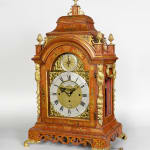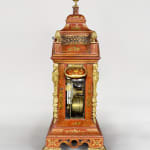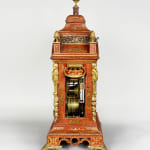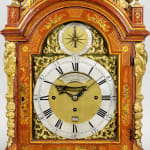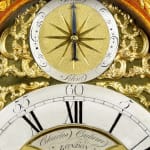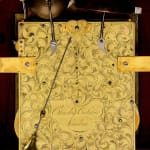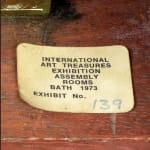CHARLES CABRIER, LONDON: A RARE EARLY GEORGE III RED JAPANNED TABLE CLOCK
Height: 24 ⅝ in ( 62.5 cm) excluding finial
Width: 16 in (40.5 cm) including feet
Depth: 10 ¼ in (26 cm) including feet
Further images
Provenance
The Collection of Henry W. Rubin and thence by descentExhibitions
International Art Treasures Exhibition Assembly rooms; Bath 1973 Exhibit No. 139A rare and exceptional early George III period chinoiserie japanned table clock, the 3 train 8 day hour striking movement with quarter chimes on 8 bells in a very original state of preservation.
The finely mounted brass dial has a silvered chapter ring with Roman hours and Arabic minute markers. The dial is signed Charles Cabrier – Londonunder XII on an inset disc. Below that is a dummy pendulum aperture in an arc. There is a subsidiary strike/silentdial within the arch and an inset date above VI.. The blued steel hands are finely pierced and appear to be original.
The foliate spandrels to the dial corners are well cast.
The substantial triple fusee movement has a fully engraved foliate backplate and heart-shaped back cock. The brass pendulum rod has an adjustable pear-shaped bob.The 3-train triple fusee movement has a verge escapement, substantial plates and six knopped pillars. Chiming the quarters on 8 bells and striking the hours on a single bell with trip repeat, the movement is typical of work by this fine maker.
The exceptional red japanned case has a very elegant bell-top surmounted by an acorn and cup finial. Four more finials, all on pediments, surround the top. The four caryatid mounts, brass side carrying handles and foliate splayed feet are finely cast and of good quality. The front and sides of the base have very unusual wooden foliate fret decoration. The red and gilt lacquer work is in pristine unrestored condition, hence its beautiful mellow red colour. The decoration comprises spays of flowers and foliage, birds, oriental pagodas, roses and figures.
Charles Cabrier
Cabrier was a distinguished third-generation London clockmaker, active from 1752 until his death in 1777, who carried forward his family’s legacy as a hallmark of horological excellence and became free of the Clockmakers' Company in 1757. Cabrier was celebrated for the exceptional quality and mechanical ingenuity of his musical, automaton, table, and longcase clocks, many of which were made for export to Europe and the Far East.
Among his most renowned creations is a pair of highly elaborate musical and automaton clocks in the oriental taste, reportedly made for the King of Nepal and illustrated in Richard Barder’s The Georgian Bracket Clock (Colour Plate 27, p. 164). With richly decorated surfaces, intricately chased mounts, and multiple musical functions, these clocks epitomise both the international demand for mechanical luxury goods and Cabrier’s skill in blending technical sophistication with exoticised design.
A distinctive feature of Cabrier’s output—particularly in pieces destined for foreign courts or cosmopolitan patrons—was the use of japanned cases. Japanning, a European imitation of Asian lacquer, became fashionable in mid-18th century England, reflecting the broader fascination with chinoiserie. These cases, often black or, as in the present example, a vibrant red, were adorned with gilded or polychrome scenes of pagodas, phoenixes, garden pavilions, and fantastical landscapes. They appealed not only to British collectors but also to elite consumers across Asia, who were intrigued by Europe’s stylised interpretations of Eastern motifs.
Cabrier was part of an elite circle of London makers—alongside figures like James Cox and Stephen Rimbault—who specialised in this hybrid style, combining the precision of English horology with decorative elements crafted to resonate with international tastes. His japanned clocks were more than fashionable objects; they functioned as instruments of diplomacy and commerce, often dispatched as luxury gifts or commercial showpieces to China, India, and other global markets. These pieces played a key role in the ceremonial and symbolic exchange between East and West, showcasing European mechanical artistry framed in a language of global exoticism.
These clocks—frequently incorporating musical movements, automata, and richly ornamented cases—belong to a wider category of 18th-century ‘exotic’ luxury goods that blurred the boundaries between technology, decorative art, and cross-cultural exchange. Their survival today, particularly when retaining their original lacquerwork and complex mechanisms, attests to Cabrier’s ability to unite craftsmanship, innovation, and worldly allure.
The present table clock is a fine example of this output: its exquisitely japanned case, elegant dial, and refined movement embody the technical brilliance and decorative sophistication for which Cabrier was known. Whether intended for an English collector or an overseas patron, it reflects the enduring appeal of his work—at once a marvel of horology and a testament to the global imagination of 18th-century design.







